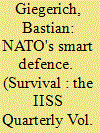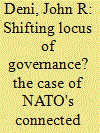| Srl | Item |
| 1 |
ID:
119316


|
|
|
|
|
| Publication |
2012.
|
| Summary/Abstract |
As the only permanent NATO Headquarters outside Europe, Allied Command Transformation (ACT) contributes to the close transatlantic cohesion between Europe and North America. Being located on US soil, and with strong links to US entities, ACT is well placed to lead NATO's transformation, and to ensure that the Alliance continues to be fit to tackle the security challenges of today and the future.
|
|
|
|
|
|
|
|
|
|
|
|
|
|
|
|
| 2 |
ID:
100409


|
|
|
|
|
| Publication |
2010.
|
| Summary/Abstract |
Anders Fogh Rasmussen is the first former prime minister to become NATO secretary general. Traditionally a role requiring behind-the-scenes diplomacy and consensus-building, Rasmussen's first year has been characterised by a break with convention. Regarded as a policy entrepreneur, his independence has reportedly provoked consternation amongst NATO ambassadors, whilst his personal media profile via Twitter and Facebook has opened the office up to public attention. Is Rasmussen a maverick or a model for the future of NATO?
|
|
|
|
|
|
|
|
|
|
|
|
|
|
|
|
| 3 |
ID:
113159


|
|
|
|
|
| Publication |
2012.
|
| Summary/Abstract |
At the 2012 NATO Summit in Chicago, Secretary-General Anders Fogh Rasmussen's 'smart defence' initiative will be a core agenda item. Rasmussen has argued that Allies need to cooperate more, and more flexibly, to prevent a deterioration in NATO's collective capability in the face of the three-pronged challenge of budget austerity, ongoing operational challenges, and a security environment characterised by deep strategic uncertainty. As he put it at the 2012 Munich Security Conference, the political initiative would amount to 'a new way for NATO and Allies to do business … this is about doing more by doing it together'. In Chicago, the Alliance was expected to agree on a political declaration providing the conceptual basis for smart defence, and to present some two-dozen multinational projects to mark the start of the initiative.
|
|
|
|
|
|
|
|
|
|
|
|
|
|
|
|
| 4 |
ID:
144766


|
|
|
|
|
| Summary/Abstract |
In early 2012, NATO's then-Secretary General, Anders Fogh Rasmussen, unveiled the Connected Forces Initiative (CFI), an effort designed to increase allied interoperability and readiness. Through three lines of effort – training and education, exercises, and better use of technology – the CFI is intended to help the alliance maintain the operational and tactical interoperability it developed in Afghanistan. At first glance, the CFI appears to represent an example of the claims of some neo-institutionalist scholars that there is a shift in the locus of governance from member states to NATO. However, this article takes a deeper look and concludes that in fact the locus of security governance is not shifting, at least not in this instance. Member states of the alliance retain several means of controlling and influencing NATO, thereby preventing it from developing a significant degree of autonomy, in contrast to the European Union or United Nations.
|
|
|
|
|
|
|
|
|
|
|
|
|
|
|
|